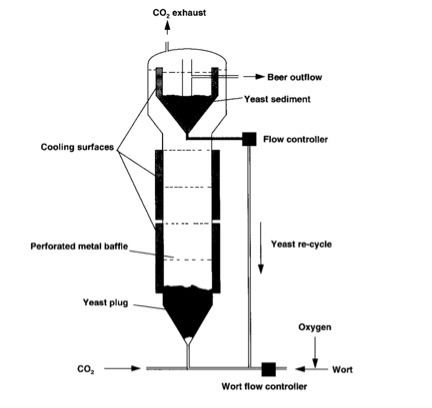From what Mark is saying about how yeast is genetically modified to stay in *suspension* until the wort dips below a threshold level of sugar
The tendency to remain in suspension until genetically set levels of glucose, mannose, maltose, sucrose, and maltriose are reached is only exhibited by yeast strains that exhibit NewFlo flocculation. The are Flo1 brewing strains where flocculation is inhibited by mannose, but not glucose. NCYC 1269 is a Saccharomyces pastorianus (lager) strain that exhibits Flo1 flocculation.
NCYC 1269
Information
Flocculent.
Flo1 type flocculation.
For use in Tower Continuous Fermenters.
Depositor
Dr. R.N. Greenshields, University of Aston, Birmingham, UK.
Deposit Name
Saccharomyces cerevisiae, Saccharomyces carlsbergensis, Sacc
Month of deposit
March
Deposit Year
1968
Habitat
Lager production strain.
Hopefully, forum members noticed the comment about the NCYC 1269 being used in continuous tower fermentation. Continuous fermentation is a very different process from how we make beer. Tower fermenters are bioreactors that are used to ferment beer using a continuous process where beer is continuously drawn off of the top while fresh wort and O
2 are added, and yeast is recycled. Fermentation occurs very quickly in a tower fermentation vessel. Ales usually ferment in around 4 hours whereas lagers ferment in around 10 hours. While exhibiting NewFlo flocculation, Whitbread "B" (a.k.a. NCYC 1026, Wyeast 1098, White Labs WLP007, and Fermentis S-04) was originally selected for use in tower fermentation vessels, which is why it is so darn flocculent.
NCYC 1026
Information
Flocculent.
NewFlo type flocculation.
1:5:4:5:5
O2, DMS 33 µg/l, low acetic, high lactic, diacetyl 0.42ppm only,
used commercially in Tower
Fermenters (continuous process), non head-forming, no estery flavour. Contains 2µ plasmid.
Depositor
British Brewery
Deposit Name
Saccharomyces cerevisiae
Month of deposit
June
Deposit Year
1958
Habitat
Ale production strain
Tower Fermentation Vessel
